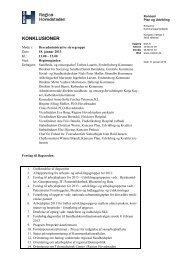Territorial Review Copenhagen - Region Hovedstaden
Territorial Review Copenhagen - Region Hovedstaden
Territorial Review Copenhagen - Region Hovedstaden
You also want an ePaper? Increase the reach of your titles
YUMPU automatically turns print PDFs into web optimized ePapers that Google loves.
61<br />
<strong>Region</strong>. The variation in tertiary education attainment across regions in<br />
Denmark is however below the OECD average. This may indicate that<br />
students migrate to other regions after attaining their degree (OECD, 2007).<br />
There has been concern about dropouts from the educational system.<br />
Completion rates in higher education are low: between 40% and 75% of<br />
students enrolled complete their bachelor‘s degree, according to some<br />
studies (OECD, 2005); 16 and between 70% and 75% according to others<br />
(Danish government, 2006). This is a low percentage, especially given that<br />
only a small proportion of the age group (18%) enrols at university and that<br />
Denmark offers the most generous student financial support in the world<br />
(free education and up to six years of grants to support living costs) (OECD,<br />
2005). Projections show that – without policy changes – around 95% of the<br />
pupils leaving primary school in 2005 will have started further education,<br />
but that only 79% will complete it; only 48% are expected to have attained a<br />
tertiary education by 2030, and less than 30% a vocational degree (Uni-C<br />
Statistik, 2007). Furthermore, deficits are projected in areas that are key to<br />
future competitiveness, such as science. Proficiency in science among 15-<br />
year-olds in Denmark is relatively low, and the number of science and<br />
engineering degrees as a share of new degrees is below the OECD average<br />
and falling (OECD, 2008).<br />
The age at which Danish students finish their studies is particularly high.<br />
The combination of high taxes in Denmark and the generous student grants<br />
encourages students to take extended breaks between secondary and tertiary<br />
education and to prolong their studies once they have started. The median<br />
age for students starting tertiary education in Denmark is around 23 years,<br />
one of the highest in the OECD. Around 40% are still enrolled six years<br />
later. This reduces lifetime earnings, leaving fewer years in which the<br />
acquired skills can be exercised in the labour market, and much of this loss<br />
is carried by public finances in foregone tax revenue. Reducing delays<br />
before the beginning of study could help to reduce dropout rates; starting<br />
late is correlated with a higher propensity to fail to complete tertiary<br />
programs where skills such as mathematics are required (OECD, 2006).

















